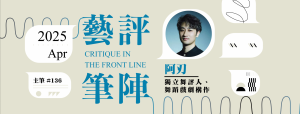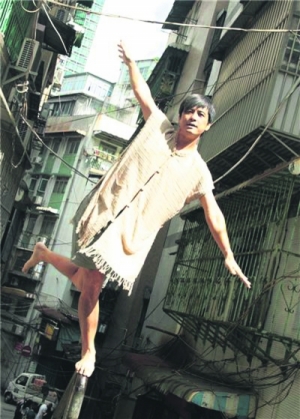The world-class period instrument ensemble Europa Galante was found in 1990 by Maestro Fabio Biondi. This Italian ensemble achieves its fame and has been heard in La Scala (Milan), Suntory Hall (Tokyo), Concertgebouw (Amsterdam), and the Royal Albert Hall (London). Tour is made throughout Australia, Japan, Europe, Canada, Israel, the U. S., and South America.
A screening of “Il Diario di Chiara”, a thirty minute-ish long film, commenced this night’s concert. The film’s idea was provided by Maestro Biondi, and realised by Lucrezia Le Moli. Basically the film portrays Chiara, in a monologic manner, recalling her life and memory in La Pietà. She recounts her glamorous history and inevitably downturns in her own live and in La Pietà. Although the film describes the 18th century Venice, it has not avoided the inclusion of contemporary shots of Venice, seemingly to reveal that such rise and fall is continued along the human history.
This night’s programme was indeed some well-rehearsed repertoires of Europa Galante. The repertoires (except RV222) were indeed included in the same titled CD-recording (Il Diario di Chiara), and were recorded as early as August 2013.
Giovanni Porta’s Sinfonia for strings in D marked the commencement of the performance. This three-movement composition was remarkably short and condensed in length, with duration of around five minutes. This light piece served as a very good start. It helped to set up the mood and atmosphere for the audience. At the same time, it tested the acoustic and the stability of their own instruments. The movements were performed uninterruptedly in an attacca manner. The first movement featured alternations and contrasts in the major and minor mode. The second movement featured a dialogue between the theorbo and solo violin. The soft movement was immediately followed by a determined and triumphant sounding finale. The ensemble ended on an abrupt perfect cadence. It was then echoed by the theorbo plucking an arpeggiated tonic chord in a repeated manner, as if the lingering echo amusingly leaked out.
The lighting on stage was dimmed for accommodating the sensitiveness of period instruments. Through the instruments had to retune several times during pauses.
Followed by Antonio Vivaldi’s Sinfonia for strings in G, RV 149, il Coro delle muse. The opening movement displayed highly delicate treatments on the dynamic contrasts. In the Andante, the combination of bowing and plucking violin sounded lively and effectively kept the music moving forward. The third movement showed the ensemble’s ability to articulate in very clean and precise manner. The precision of articulation was especially demonstrated through the G-E strings crossing on violins. Also the whole ensemble precisely performed the energetic and abrupt descending runnings of demisemiquavers. These created a highly astonishing and convincing sonority which one deeply admired.
A reduced instrumentation was shown in the next piece, Niccolò Porpora’s Sinfonia a tre in G major. The audience had a temporarily break from the sonority of a tutti ensemble, where the instrumentation became two violins, and four basso instruments: theorbo, cello, bass, and keyboard (organ in Adagio; harpsichord in Allegro). This two-against-four combination maintained a good balance, both in terms of timbre and dynamics. A lyrical and smooth duet on the violins was heard in the Adagio, their closely paired relationship gave a soothing and peaceful sonority. The two violins continued the music in a relaxing manner in Allegro. The ending of Allegro featured an abrupt pause on the dominant, followed by a slightly delayed and brief appearance of tonic.
This miniature was then followed by two concerti that were particularly dedicated to Signora Chiara, as noted on the programme booklet. The first one was Antonio Martinelli’s Violin Concerto in E, Dedicato all Signora Chiara. Maestro Biondi revised the piece and made the cadenzas. These passages were pretty in style. The soloist clearly understood the style that he was playing. The cadenzas displayed a slight hint of Classical style in several aspects. Firstly, the way of entering the cadenza; secondly, the cadenza in the third movement was more chromatically decorated, and more double stops were involved. Merely three instruments performed the second movement: two violins accompanying the solo violin. In terms of instrumentation, it was a very clever choice. It helped to fully display the fluidity of the soloist.
The next concerto was Vivaldi’s Concerto for Violin in D, RV222. It was a good choice to conclude the first half of concert before the interval. It displayed a very skilful writing for solo violin and was probably the most technically demanding piece this night. Maestro Biondi’s virtuosity was fully revealed through this challenging composition. The stability was well maintained even in the high register, articulations were precise and clean. His masterful bowing techniques were fully noted in the third movement. Maestro Biondi’s virtuosic performance even provoked a brief and timid applause after the first movement.
The viola d'amore, a very delicate and beautiful instrument that respectively having seven playing and resonating strings, started the second half of performance. Another piece by Martinelli, Concerto for viola d'amore and strings in D was performed. The piece was a dedication to Chiara, and the cadenza of the third movement was indeed composed by Chiara. But it seemed that the featured instrument was a bit sensitive to its surrounding, where instability in the lower register was noted. Furthermore, its intended celestial resonance was not prominent, even in the solo and exposed passage in the second movement, where all the accompaniments had already dropped out. It would probably be a problem of acoustics of the venue.
Succeeding the solo concerto, the tutti ensemble sonority was then resounded. The Allegro in Andrea Bernasconi’s Sinfonia for strings in D gave a lively contrast to the previous piece. The arrangement of performance was unusual. After the end of the first movement, Fulgenso Perotti’s Grave for violin and organ in G minor was heard. Grave featured a sweet dialogue between the two instruments. Yet an unwelcoming ringtone, which precisely intervened after Grave, deserved a smirk from Maestro Biondi. The two later movements of Bernasconi’s Sinfonia were then continued.
The final piece, Gaetano Latilla’s Sinfonia for strings in G, provided a contrast to the previous pieces. It was more associated with style galant, which suited the ensemble’s name pretty well, Europa Galante. This piece sounded more close to the Rococo style instead of Baroque. Originally it was positioned as the third piece after the second interval. This particular rearrangement of programme order was a good move. Martinelli’s music had a hint of early Classical style, but not as much as Latilla’s Sinfonia. Hence this style galante piece was pretty fresh to the audience’s ears. The first movement was energetic and light. The dance like second movement had a hint of pastoral taste, with consistent movement of quavers in 6/8 time. It employed frequent use of deceptive cadence, and the lines were especially chromatically decorated. The harmonic language was more adventurous in this piece; this was especially heard in the third movement where a unison chromatic descending line intervened for several times. The third movement succeeded the triple meter and dance-like atmosphere, ended the night’s programme with contented conclusiveness.
Europa Galante’s performance deserved passionate applause from the audience. To reward the audience, Maestro Biondi announced their first encore piece, “we will play a little surprise to you, […] dedicate to all the women that have difficulties in life,” what a timely dedication just before the International Women’s Day. This short announcement was immediately followed by a stormy and tense movement, Vivaldi’s RV 315, "Presto - L'estate (Summer)." The breathtaking tempo held every audience’s breath. The precise and consistently powerful playing from the cheongsam-wearing harpsichordist, Signora Poncet, was worth noted. Her intended mechanical articulation was highly convincing and well accompanied the piece. The emotionally overwhelming two minute-ish “dedication” was then followed by a less challenging piece by the same composer, Vivaldi’s RV 297, "Largo - L'inverno (Winter)." The improvisation by Maestro Biondi offered a delightful display of the music. The cheerfully detached bowing on the cello was another light-hearted spot. It was echoed by his colleague with a plucking sonority. This combination of arco and pizzicato strings was although not written on the score, it is a commonly heard technique in Vivaldi’s music (also noted in RV149 of this night). This light degree of revising the score showed the flexibility on performing Baroque music. It also vividly demonstrated the interpreters’ knowledge.
After all, the whole concert and film production was paying homage to the female violinist Chiara, as noted in Maestro Biondi’s speech. Possibly this served as a connection to the rationale of the 43rd Hong Kong Arts Festival, where Ms. Tisa Ho, Executive Director of HKAF, noted in the front page of programme booklet. The current Festival “is resplendent with brilliant Divas, marking the 40th anniversary of International Women’s Year and celebrating the half of humanity that holds up half the sky.” Such connection is well observed in the 43rd HKAF.
It is a pleasant to see the inclusion of authentic period repertoire. Four concerts of HKAF are featured with Baroque compositions, and Maestro Biondi had already contributed a Baroque violin recital on 6th March. We realise the efforts of HKAF on gathering as much variety as possible. However, the audience still has long way to go. As a dialogue was overheard during the interval, "Do not you think that every piece sounds the same?” a father said to his child. Not to complain on the general lack of appreciation in early music, but we really see an urge to promote more of the discussed repertoire. Anyway, HKAF did a great job on negotiating with the Europa Galante, for bringing a fabulous night to the local audience. The two and a half hour performance was a pretty fruitful one, where audience enjoyed a great variety of period repertoire. Audience also experienced the sonority of period instruments, which were rarely heard in Hong Kong. Europa Galante is definitely a highly welcomed option to be reheard in Hong Kong.
本網站內一切內容之版權均屬國際演藝評論家協會(香港分會)及原作者所有,未經本會及/或原作者書面同意,不得轉載。










